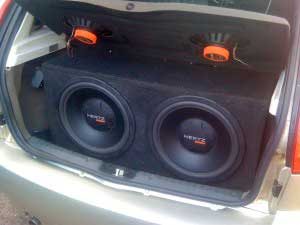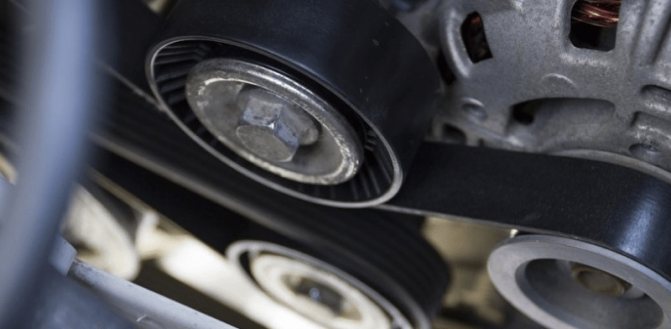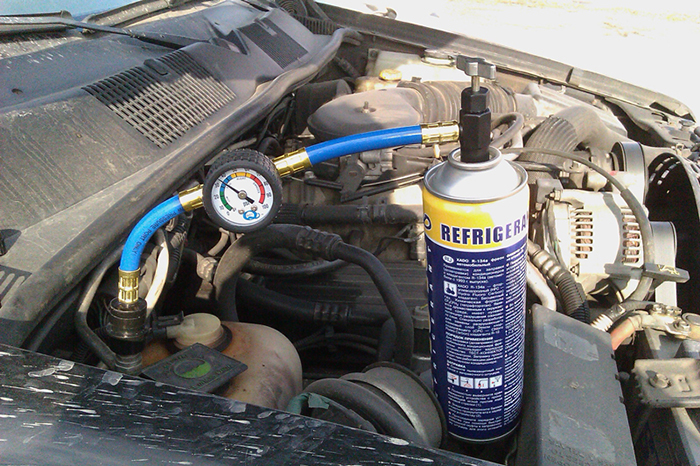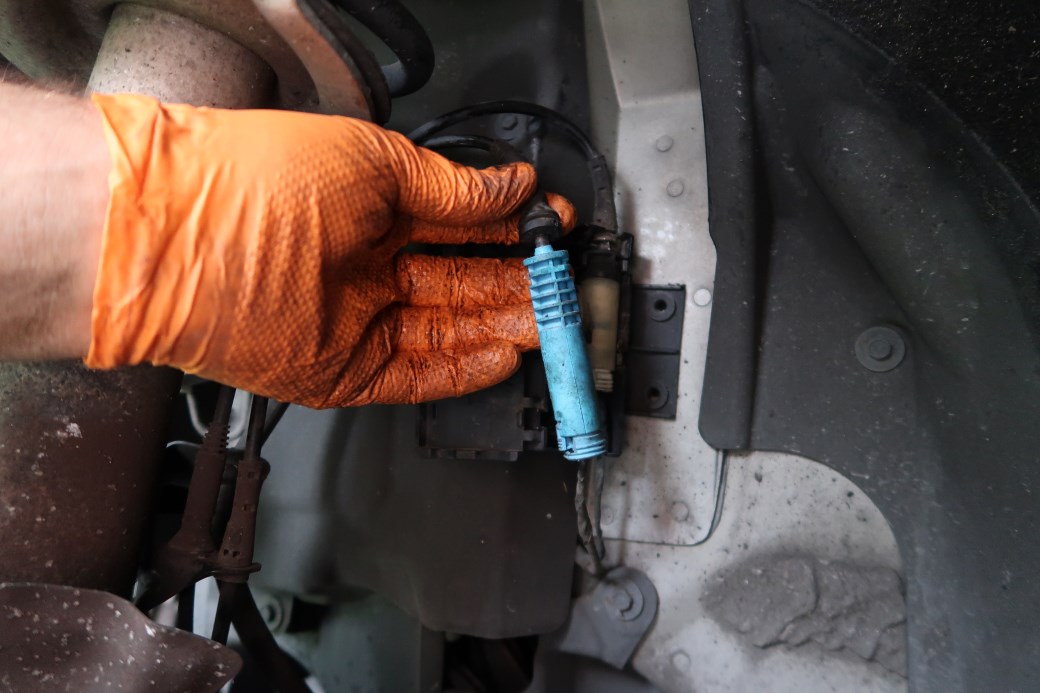 The subwoofer is a separately installed speaker system, which is designed to play low-frequency sound waves in the range of 20-120 Hz.
The subwoofer is a separately installed speaker system, which is designed to play low-frequency sound waves in the range of 20-120 Hz.
It sounds only at low frequencies when the central speaker system is only at high and medium.
Low-frequency sound is unrecognizable by the human ear so that it can be mounted anywhere in the car.
Self-production of a subwoofer is quite simple job. You need to start with the purchase of speakers.
Types of subwoofers
There are passive and active subwoofers:
- The passive subwoofer is a housing with a built-in speaker. For correct operation of this type of subwoofer, an external amplifier with sufficient power is required.
- The active subwoofer comes with its built-in low-frequency amplifier with volume control. Many active subwoofers also have bass controls and high-frequency trim. This is necessary for the sound from the subwoofer to be consistent with the speaker system. The most significant drawback of this type of subwoofer is its high price.
Did you know that it is possible to buy a 15-inch subwoofer under $200. Read our guide with the best 5 models available in the market today.
Selecting speakers for subwoofer
Typically, subwoofers use speakers of the following sizes:
- Six-inch speakers used as additional mid-bass frequency sources.
- Eight-inch speakers used for front bass.
- Ten-inch speakers perfectly reveal their potential in a closed case with a volume of 15-20 liters. Thus, a good subwoofer of compact size with optimal sound pressure is obtained.
- Twelve-inch speakers are optimal for housings from 25 to 35 liters. This is perhaps the best option.
- Fifty-inch speakers are often used on competitions in sound pressure. They are built only in the body from 60 to 90 liters, and such a device will not fit in every car.
The basis of the resistance difference in the sound coil operates on the principle: the lower the load resistance of the amplifier, the higher its power. Load in 1-2 Ohms leads to deterioration of sound quality. It is recommended to choose twice the load in 2-4 Ohms.
Neither the professionals nor the amateurs have not yet reached a consensus regarding the power characteristics of the speakers. But what can be confirmed with confidence is the need to choose a speaker that exceeds the power of the amplifier. No audio system is adapted to long-term operation at peak power. This leads to an increase in nonlinear distortion and a substantial underestimation of the quality of the reproduced audio signals. Therefore, you should stick to a certain balance.
You may also like: Best 6.5 Speakers For Clarity – Buyer’s Guide – https://carinmydna.com/best-6-5-speakers-for-clarity/
Types of box construction
There are four most popular types of subwoofer boxes. The design features of boxes directly affect the quality of the sound produced at the output.
Closed box is the easiest option in modeling and manufacturing. Its name expresses its essence. The subwoofer speaker is placed in a covered wooden case, improving its acoustic performance. It will not be difficult to make such a case, but the efficiency is the lowest of all presented.
Bandpass of the 4th order represents a housing divided into chambers of different volume. In one of them placed the speaker and in the other – duct. The peculiarity of this subwoofer design is the possibility of limiting the frequencies reproduced by the diffuser.
Bandpass of the 6th order differs from the previous only in that it has one additional air duct. This type of construction is the most difficult to design and create, but has a maximum level of efficiency.
Phase inverter – enclosure with a mounted pipe that gets the air out. This tube additionally provides sound from the back of the subwoofer. For quality sound characteristics and complexity of manufacturing, this type can be put between the “CB” and “Bandpass.”
Material selection and tools required
The necessary materials for creating the body of the subwoofer:
- Speakers, choosing which, you need to know the difference in their characteristics. Usually in the instructions or on the box indicates the recommended design for this speaker.
- A sheet of plywood, fiberboard, chipboard. The amount must be calculated based on the size of the future box.
- Acoustic terminal. Optional element. You can drill a couple of holes through which to bring out the wires from the speaker.
- Speaker cable.
- Sealer.
- Screws for wood.
- Epoxy resin.
- Varnish or paint.
- Glue for carpet. The one in the can is convenient.
- A tunnel of suitable size is required for the phase inverter housing. If you do not find the right one on sale, then in the store of building materials buy the pipe of the desired material. Plastic, cardboard and even metal will work.
The tools needed to create the body of the subwoofer:
- Jigsaw.
- Screwdriver.
- Tape-measure.
- Pencil or marker.
- Carpet or other material for the outer skin of the body.
- Scissors.
The stages of construction of the body
- Cut out the walls of the body relative to its size. You need to cut in compliance with the dimensions, thoroughly measuring out. When assembling the gaps should be minimal. Ideally, the body parts should fit as tightly as possible to each other.
- Lubricate the joints of the walls with sealant and connect them. Secure them further with screws in increments of five centimeters.
- Re-lubricate the joints both outside and inside. Do not allow even the smallest of holes, since you will hear the whistle through them during the work of the subwoofer.
- Cut a hole for the acoustic terminal in a convenient place.
- Cut a hole for the speaker with a jigsaw.
- If the box is provided for a phase inverter subwoofer, then the corresponding port sits in the corresponding hole on the epoxy resin.
- To protect the body from moisture, it must be varnished or painted.
- Cover the case with carpet or other material, leaving holes for the speaker, port and terminal.
- Put the terminal in its place and secure it with screws, additionally brush with epoxy.
- Secure the wires with the terminals inside the terminal. Connect the other side of the wire to the terminals on the speaker. The wires should not sag. The length should be enough for connection.
- Mount the speaker in place. Seal the joint between the speaker and the box with a gasket. If this is not included with the speaker, you can use foam or window seal.
- Attach the speaker to the housing with the screws that came with it or any other suitable.
Body fabrication
Now let’s talk more about how to make your subwoofer and mount it in the car. The most convenient and universal form of the case is a slightly truncated pyramid. Since most cars in the standard position, the rear seat is tilted at 23 degrees, so the back wall of the subwoofer is inclined at the same angle. After determining the required space, calculate the size of the housing and draw a drawing of the future wooden house.
Closed box
The front wall is better to make from chipboard with a thickness of 23 mm, side – 20mm. Cut out from the material of the wall according to the dimensions in the drawing and then build the case. All joints are better to lubricate with glue and fasten with screws. Holes are better to drill 3 mm, and under heads, it is better to take a drill with a diameter of 1 cm. Further on the side with the compass make marks for future speaker terminal. Cut them out with an electric jigsaw. The terminal under high pressure can make unnecessary sounds. To avoid this, shield it with a small box, then brush the joints with glue and secure with screws. Cut off all the extra tabs with a plane.
In the front, mark and cut a hole for the speaker in the same way. To protect from moisture saturate the body with nitrocellulose lacquer. It can also be applied to the inner end of the front panel. To be more attractive and practical housing can be outside to paste over the carpet. It is glued to the same nitro varnish. Attach the speaker to the speaker terminal and attach them to the housing.
Phase inverter
Cases for this type of subwoofer are quite bulky. Such a subwoofer is challenging to calculate and adjust, but such a homemade element of the car speaker system has a higher efficiency than the previous version. In this case, the parameters are also calculated using special software. Assembly of the body is carried out as in the last version, but it must also be carefully sanded. Next, cut the holes for the phase inverter, pens, pockets, and outlet. Install all fasteners and check them thoroughly. The body can be covered with leather.
Bandpass of the 4th order
For the manufacture of the housing for this type of subwoofer should be taken by those who have experience in carrying out calculations, because it is difficult to calculate and easy to make a mistake in size. But bandpass gives a beautiful sound and has good efficiency. Also, it is well protected from external mechanical damage, as wholly hidden in the body. Calculations are also carried out using computer software, but not only the whole body, but also each of the cameras separately. When you cut out the details, stick as closely as possible to all sizes.
The design is assembled, as in previous versions. The partition with the speaker is made of two sheets of chipboard. Inside the body is glued with sound-absorbing material, batting, for example. Glue is applied in small strokes over the entire area. Do not pour a lot of glue to avoid static properties. Fixing a design with a construction stapler also is possible. Solder the wires to the terminal and the speaker. The rear chamber must be adequately sealed. The greatest tightness is achieved thanks to liquid nails and tape glued over the seam.
The bell of the phase inverter is made by heating the edges with a jar and expanding them. In the hole cut with a jigsaw in the lid is placed carpet with a phase inverter — connection over liquid nails. The cover with a phase inverter behind is pasted with a noise-absorbing material. Assemble a ready subwoofer and glue with the carpet.
Bandpass of the 6th order
This is the most difficult to assemble and in the calculations subwoofer. It is not necessary to come here without thorough preparation. Comparable to the previous option, but gives a much broader frequency range. Efficiency and power it is difficult to calculate even with the help of simulation programs. As a rule, all parameters are selected exclusively on personal preferences.
The design of the body is much more complicated than in previous versions. That connection came out much stronger; they are made of wooden bars fixed with screws. All parts are cut strictly according to the calculated size. Everything is done further on the technology similar to bandpass fourth, only as additional sound insulation material use wool.
That’s interesting! Guinness World record holder Tim Storms reproduces the note of the salt of the subcontinent at a frequency of 0.189 Hz. This sound is so low that even the singer cannot hear it.
Homemade subwoofer – stealth
This type of subwoofer is hidden as much as possible and almost does not take up space in the trunk, so it is very convenient to use in the car. It is usually installed in the trunk behind the rear arch. For good speakers requires a body of 18 liters, and sometimes more. The body can be slightly removed inside the trunk, as well as place the subwoofer in the niche, which is designed for “spare.”
Mounting the subwoofer-stealth, it is necessary to extend its front panel a little and connect it to the luggage compartment upholstery. From corrugated cardboard it is required to build a form, gluing its pieces with masking tape. Assemble the amplifier frame and try on the equipment. Next, make a fiberglass cladding panel for amplifiers that are already installed on the frame.
Backlight on subwoofer
Both LEDs and diode tape can be used to illuminate the subwoofer. LEDs have two contacts: anode (A) and cathode (K). For the correct connection of LEDs, it is necessary to connect touch A to the plus on the power supply, K to the minus. Resistors of each led are soldered to the Anode separately. Determine in advance how you will mount the LEDs inside the subwoofer. It is better to place them so that they stick together and hard. The EQ sensor must be positioned away from the subwoofer so that it is not damaged.
If the led strip is used as a backlight, then the fixing of the diodes is replaced by mounting the tape. This will make it easier for you to install, as they are already carefully adjusted to each other and well fixed. Mount the tape just inside the subwoofer on double-sided tape. With this option, you can find very different design solutions. For example, a ring of LEDs around the speaker, the brightness and color of which can be chosen as you like.
Every car owner who tunes his car, guided for the most part only by their preferences, taste, and imagination. What experts recommend, it is taken as a rule as advice. The same can be said about how to create subwoofers yourself with their further installation.


